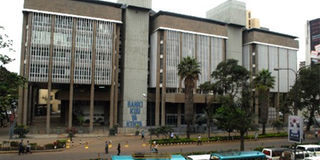Customers bear burden of high lending rates as banks reap big

The Central Bank of Kenya along Haile Selassie Avenue on October 15, 2012. As debate on the need to cap borrowing rates continues, a report released by the Central Bank of Kenya shows that the high interest charged by commercial banks has seen them almost double their profits in just three years. PHOTO / SALATON NJAU / NATION
What you need to know:
- At a market average of 16.9 per cent, the lenders charge an interest rate double that of the Central Bank of Kenya.
- Experts warn that the high interest rates could hurt the banks in the long run.
As debate on the need to cap borrowing rates continues, a report released by the Central Bank of Kenya shows that the high interest charged by commercial banks has seen them almost double their profits in just three years.
The 2013 Banks Supervision Survey Report released by CBK shows that commercial banks made a combined profit before tax of Sh125 billion in 2013, almost double the 2010 profit of Sh74.3 billion and over twenty times that of 2002.
In 2002, the industry’s profit hit Sh6 billion which more than doubled to Sh14.1 billion after the Kibaki administration came to power the following year.
Defending the huge margins, Kenya Bankers Association chief executive officer Mr Habil Olaka, described banking as an important sector that needs to be stable because it supports economic growth.
“If banks make losses, the impact will reverberate across the whole economy. Growth of the sector tends to pull the whole economy with it,” Mr Olaka said.
THE LEADERS
Equity Bank leads with Sh18.2 billion, followed by KCB with Sh17.7 billion and Standard Chartered with Sh13.3 billion.
Barclays Bank is fourth with Sh11.9 billion, followed by Co-operative Bank with Sh10.7 billion and CFC Stanbic with Sh7 billion.
The six banks, according to the CBK report, command 52.39 per cent of the banking sector market share and made a combined profit of Sh78.9 billion before tax.
Banking has emerged as the country’s most profitable sector. Last year, only three of the country’s 43 banks made losses. The three are Ecobank Kenya Sh1.2 billion, UBA Sh278 million and Consolidated Bank Sh142 million. Of the profit-making 39, 19 managed more than Sh1 billion.
Charterhouse Bank has not been releasing its figures since it was put under receivership in 2004. London-based Standard Chartered announced that its 2013 income in Africa increased by 10 per cent to Sh45 billion ($529 million), with Kenya being its largest consumer banking income generator, growing 11 per cent in that sector alone, reported AFP.
The huge profits have rekindled debate on the need to rein in the banks by capping interest rates.
CASH COW
While CBK’s Monetary Policy Committee has maintained the lending rate at 8.5 per cent for the last one year, commercial banks are giving loans at an average interest rate of 16.9 per cent.
Conversely, banks pay an average of 6.65 per cent as interest on deposits. The CBK report shows that interest rates are the cash cow, as the 42 banks made Sh271 billion from that alone, which accounts for 76 per cent of their total income.
There is, however, light at the end of the tunnel as far as interest rates are concerned.
This month, the KBA and the Treasury announced that commercial banks had begun the pilot implementation of the annual percentage rate (APR) pricing mechanism, which will enable consumers to compare different bank-loan costs based on standardised parameters and a common computation model.
Mr Olaka added that effective July 1, banks will disclose the total costs associated with loans, the loan repayment schedule and the APR, which takes into account the interest rate component, bank charges and fees, and third-party costs, including legal fees, insurance costs, valuation fees and government levies.
BUSINESS ETHICS
“We are enhancing pricing disclosures to enable customers make informed choices,” said Mr Olaka. “This is one mechanism embraced by banks to address issues related to ease of credit access.”
President Uhuru Kenyatta, his deputy William Ruto and CBK have constantly pleaded with commercial banks to cut lending rates without much success.
“Banks and other financial institutions need to work in partnership with the government to make credit both accessible and affordable. This will attract a bigger customer base,” said the President, adding that the government could soon introduce a Bill to cap interest rates.
Mr Ruto called for a national debate on the issue: “How can saccos lend at 12 per cent while banks do so at rates of between 18 and 25 per cent? Which business can one do and make profits while paying a loan with such an interest rate?” posed Mr Ruto in January.
In the US, the base rate of interest is set by the Federal Reserve Bank quarterly. But owing to somewhat good business ethics and strong consumer-protection institutions funded by the government, the banks are a bit disciplined and tend to behave as if the rate is legally capped. Few charge more than two per cent above the base rate.
DEMAND AND SUPPLY
The same applies to the UK, where the banks rarely set their rates at more than two per cent above the base rate set by the Monetary Policy Committee.
At an average of 16.9 per cent, Kenyan banks are charging interest rates double that of CBK.
An expert at the Institute of Certified Public Accountants of Kenya says the problem in Kenya lies in the fact that interest rates are dictated by the banks instead of the laws of demand and supply.
Mr John Kiarie, head of consulting at Deloitte East Africa, warns that the high interest rates could hurt the banks in the long run.
“If banks do not change, competitors with more cost-efficient operating models will come into the market and force much lower rates,” says Mr Kiarie.
Already, M-Shwari, a joint banking mobile phone-based service between Safaricom and Commercial Bank of Africa, has proven popular as it charges just 7.5 per cent as facilitation fee payable only once for each loan taken.
UNDERHAND TACTICS
But even as President Kenyatta threatens to use Parliament to cap interest rates, it is not lost on Kenyans how previous attempts failed amid claims of bribery.
The most recent was in 2012, when Gem MP Jakoyo Midiwo introduced an amendment in the Finance Bill seeking to amend Section 16A of the Banking Act to have the maximum interest rate that banks can charge on loans pegged at not more than four per cent the rate set by the MPC.
Had Mr Midiwo’s amendment passed, all banks would be charging a maximum of 12.5 per cent as interest on loans.
His bid, however, fell flat amid claims that some influential banks successfully used uncouth means to lobby MPs into scuttling it.
Then Gichugu MP Martha Karua and nominated MP Millie Odhiambo alleged that some legislators received Sh50,000 to oppose Mr Midiwo’s amendments.
Economist Mr Joe Donde, also a former Gem MP, attempted to introduce similar amendments in 2001, which suffered a similar fate.
Mr Jaindi Kisero, a Nation editor who comments on financial matters, argues that beyond using underhand tactics, the banking fraternity has powerful allies, especially within the Treasury and the CBK, hence the tough talk and no action.





